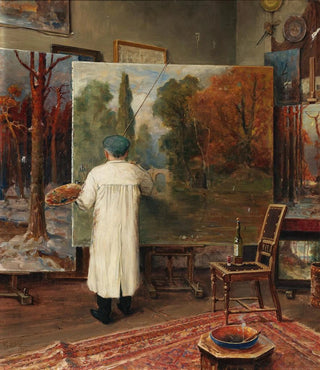Art print | In his studio - Julius Sergius Klever


View from behind

Frame (optional)
In the enchanting world of art, some works manage to capture the very essence of creation. "Dans son atelier - Julius Sergius Klever" is a perfect example. This piece invites the viewer to step into the intimacy of a space where art and life blend harmoniously. Through the depiction of an atelier, Klever does not merely portray a place; he evokes an atmosphere, a mood filled with creativity and passion. The work acts as a window into the artistic process, revealing the mysteries and inspirations that nourish the artist's soul. Through this art print, the gaze is guided toward meticulous details and the play of light that bring this scene to life, thus conveying the palpable energy emanating from each brushstroke.
Style and uniqueness of the work
Julius Sergius Klever's style is distinguished by an undeniable mastery of realism, combined with an impressionist sensitivity. In "Dans son atelier," the colors intertwine delicately, creating a visual harmony that transports the viewer. Subtle nuances, delicate shadows, and light filtered through the windows give the piece an almost dreamlike atmosphere. Klever excels in depicting textures, whether of furniture materials, fabrics, or art objects that populate the atelier. Each element becomes a fully-fledged actor, contributing to the visual storytelling. The artist manages to capture not only the appearance of objects but also their essence, their history, transforming a simple scene into a true artistic statement.
The artist and his influence
Julius Sergius Klever, a painter of Russian origin, established himself as a major figure of the 19th century. His artistic journey is marked by an relentless quest for perfection and authenticity. Influenced by the great masters of his time, he developed a style that is uniquely his own, blending tradition and modernity. Klever was also a keen observer of his era, incorporating elements of daily life into his works. This approach allowed him to create compositions that still resonate today. His influence extends to

Matte finish

View from behind

Frame (optional)
In the enchanting world of art, some works manage to capture the very essence of creation. "Dans son atelier - Julius Sergius Klever" is a perfect example. This piece invites the viewer to step into the intimacy of a space where art and life blend harmoniously. Through the depiction of an atelier, Klever does not merely portray a place; he evokes an atmosphere, a mood filled with creativity and passion. The work acts as a window into the artistic process, revealing the mysteries and inspirations that nourish the artist's soul. Through this art print, the gaze is guided toward meticulous details and the play of light that bring this scene to life, thus conveying the palpable energy emanating from each brushstroke.
Style and uniqueness of the work
Julius Sergius Klever's style is distinguished by an undeniable mastery of realism, combined with an impressionist sensitivity. In "Dans son atelier," the colors intertwine delicately, creating a visual harmony that transports the viewer. Subtle nuances, delicate shadows, and light filtered through the windows give the piece an almost dreamlike atmosphere. Klever excels in depicting textures, whether of furniture materials, fabrics, or art objects that populate the atelier. Each element becomes a fully-fledged actor, contributing to the visual storytelling. The artist manages to capture not only the appearance of objects but also their essence, their history, transforming a simple scene into a true artistic statement.
The artist and his influence
Julius Sergius Klever, a painter of Russian origin, established himself as a major figure of the 19th century. His artistic journey is marked by an relentless quest for perfection and authenticity. Influenced by the great masters of his time, he developed a style that is uniquely his own, blending tradition and modernity. Klever was also a keen observer of his era, incorporating elements of daily life into his works. This approach allowed him to create compositions that still resonate today. His influence extends to






